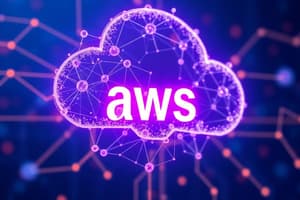Podcast
Questions and Answers
Cloud computing provides ______ resource pools that can be allocated to meet demand.
Cloud computing provides ______ resource pools that can be allocated to meet demand.
flexible
IaaS, PaaS, and SaaS are different ______ models of cloud computing.
IaaS, PaaS, and SaaS are different ______ models of cloud computing.
service
Cloud computing provides ______ scalability, allowing users to scale up or down as needed.
Cloud computing provides ______ scalability, allowing users to scale up or down as needed.
on-demand
One of the key benefits of cloud computing is ______ maintenance, which is managed by the provider.
One of the key benefits of cloud computing is ______ maintenance, which is managed by the provider.
Machine learning is a process used to achieve ______ intelligence.
Machine learning is a process used to achieve ______ intelligence.
Deep learning is a subfield of ______ learning that draws inspiration from how the brain works.
Deep learning is a subfield of ______ learning that draws inspiration from how the brain works.
Supervised learning involves ______ data to learn from.
Supervised learning involves ______ data to learn from.
Reinforcement learning involves ______ itself using trial and error.
Reinforcement learning involves ______ itself using trial and error.
Cloud computing provides ______ accessibility, allowing users to access resources from anywhere.
Cloud computing provides ______ accessibility, allowing users to access resources from anywhere.
Service Level Agreements (SLAs) define the ______ of service provided by a cloud provider.
Service Level Agreements (SLAs) define the ______ of service provided by a cloud provider.
Flashcards are hidden until you start studying
Study Notes
Cloud Computing
- Flexible self-service, network-accessible computing resource pools that can be allocated to meet demand.
- Service models: IaaS, PaaS, SaaS.
- Deployment models: Private, Public, Hybrid.
- Benefits:
- Scalability
- Storage
- Security
- Data-loss prevention
- Maintenance
- Pay-per-usage of resources
- Accessibility
- Managed by the provider
- Flexible resource assignment
- Characteristics:
- Network accessible
- Sustainable
- Managed through self-service on demand
- SLA: Service Level Agreements
Machine Learning
- Definition: Process used to achieve artificial intelligence, involving designing algorithms that can learn from data to become more accurate and effective over time.
- Categories:
- Supervised learning
- Unsupervised learning
- Reinforcement learning
- Supervision:
- Classification: yes or no
- Regression: continuous
- Clustering: un-supervised
- Reinforcement learning:
- Training itself using trial and error
- Models learn from external interactions and improve with time
- Applications:
- Widely used in gaming, robotics, and industrial automation
- Healthcare and online stock trading
- Deep learning is a subfield of machine learning, inspired by how the brain works
Studying That Suits You
Use AI to generate personalized quizzes and flashcards to suit your learning preferences.



